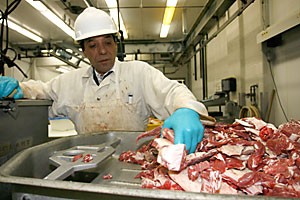While some campus organizations hold bake sales or sell vagina-shaped chocolate lollipops, the UA Meat Science Laboratory offers cuts of steak and sausages.
The UA meat lab, part of the College of Agricultural and Life Sciences, is a federally inspected facility used for research, animal processing and educating students on food safety and meat sciences.
The lab, located at 4101 N. Campbell Ave., was built in 1988. While other universities’ meat labs are being closed due to budget constraints, the UA’s lab is an advanced facility, said Dr. John Marchello, a meat scientist who teaches and does research at the lab.
The state-of-the-art facility is outfitted with freezers, refrigerators, meat smokers and other cooking and cooling equipment.
Refrigerators cool the classrooms where subjects such as meat sciences and food safety are covered.
“”We cover vegetables, meat, seafood, dairy,”” Marchello said. “”We cover the gamut on safety issues.””
The lab also “”processes”” animals for many outlets, such as Arizona county fairs and 4H groups.
Animal processing involves the harvesting, or slaughter, of the animal and the butchering of the animal into salable pieces of meat. The majority of animals processed at the facility are cows, sheep, swine and goats. The meat lab can also process more unusual animals such as deer, buffalo, elk, emu and ostriches, as well as organic meat, and can approve natural meat labels for ranchers, Marchello said.
In addition to processing animals, members of Arizona’s 4H program tour the lab and participate in livestock judging and carcass evaluation contests, said Bob Peterson, a youth development agent for Pima County 4H.
Groups from Pima County 4H tour the lab three to four times per year. The children who participate in 4H range from 9 to 18 years old, Peterson said.
“”They learn about what the animal looks like hanging rather than standing up,”” Peterson said.
Livestock judging contests are held once or twice a year by the lab, and participants evaluate animals and animal
carcasses for criteria such as meat quality and characteristics.
Research conducted at the facility is aimed at improving meat quality among herds. The lab studies the quality of herds and food safety issues.
For example, the lab processes cattle from the V Bar V Ranch, located in Cottonwood, an extension of the
College of Agriculture and Life Sciences. The lab then conducts research on the herds at the ranch.
“”We take information back that we get and select sires to improve the herd from the standpoint of carcass merit,”” Marchello said.
Food-borne illnesses and food safety are also researched at the meat lab. The findings are then used to improve the quality and shelf life of food products, Marchello said.
The lab also contributes to anatomy research and education for other groups by providing portions of animal carcasses for study. About 65 groups receive parts of animals, such as hearts or eyeballs, for dissection and study, Marchello said.
The meat lab has trained people to become meat cutters, including some workers who were laid off after the closing of the San Manuel mine in Pima County. The mine was fully closed in October 2003, said Diane Bain, the public information officer at the Arizona state Department of Mines and Mineral Resources.
After being laid off from the mine, Tom Van Haren trained to become a lab aide assistant and now works at the lab.
Van Haren, who was a welder at the San Manual mine, estimated that 30 workers fired from the mines were retrained by the meat lab and work in positions at grocery stores and other places. Four who were retrained now work in the lab, Marchello said.









